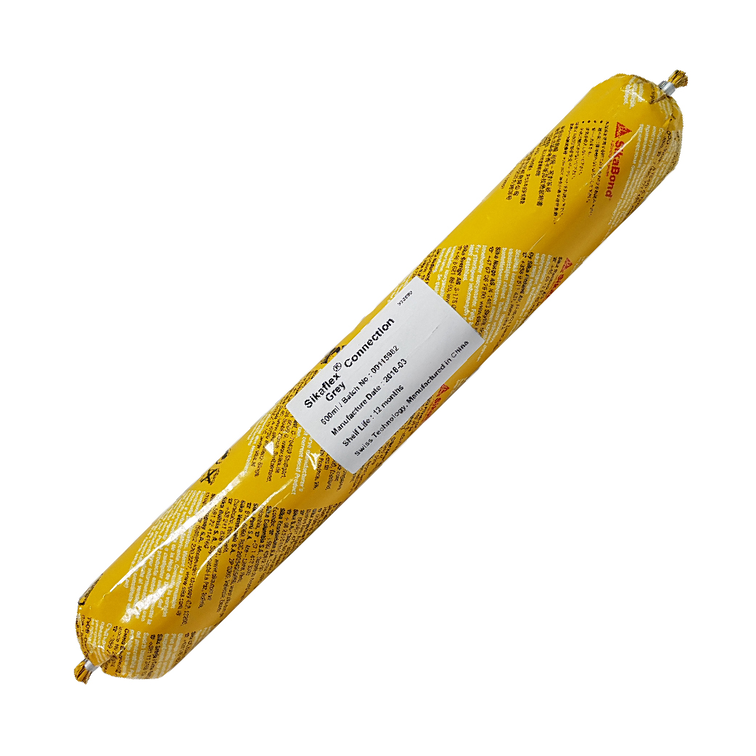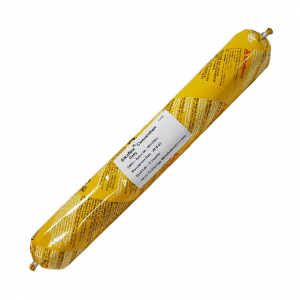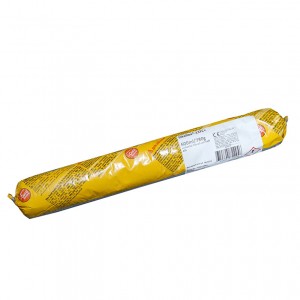Sikaflex® Connection SEALANT FOR CONNECTION JOINTS IN CONSTRUCTION BUSINESSES
Features &Benefits
- -Movement capability of ± 25 (ASTM C 719)
- -Good workability
- -Good adhesion to many substrates
Product Information
Composition
Polyurethane
Shelf life
Sikaflex® Connection has a shelf life of 12 months from the date of production, if it is stored in undamaged, original, sealed packaging, and if the storage conditions are met.
Storage conditions
Sikaflex® Connection shall be stored in dry conditions, where it is protected from direct sunlight and at temperatures between +5 °C and +25 °C.
Density
| ~1.40 kg/L |
Technical Information
Shore A Hardness
| After 28 days | ~42 |
Secant Tensile Modulus
| at +23 °C
(60 % elongation) |
~0.75 N/mm2 |
| at -20 °C
(60 % elongation) |
~1.06 N/mm2 |
Elastic Recovery
| ~90 % |
Tear Propagation Resistance
| ~7.0 N/mm |
Movement Capability
| ± 20 % | (ISO 9047) |
| ± 25 % | (ASTM C 719) |
Service Temperature
−40 °C to +70 °C
Joint Design
The joint width must be designed to suit the joint movement required and the movement capability of the sealant. The joint width shall be ≥ 10 mm and ≤ 40 mm. A width to depth ratio of 2:1 must be maintained (for exceptions, see table below).
Standard joint widths for joints between concrete elements
| Joint distance [m] | Min joint width [mm] | Min. joint depth [mm] |
| 2 | 10 | 10 |
| 4 | 15 | 10 |
| 6 | 20 | 10 |
| 8 | 30 | 15 |
| 10 | 35 | 17 |
All joints must be correctly designed and dimensioned in accordance with the relevant standards, before their construction. The basis for calculation of the necessary joint widths are the type of structure and its dimensions, the technical values of the adjacent building materials and the joint sealing material, as well as the specific exposure of the building and the joints.
For larger joints please contact our Technical Service Department.
Applications
Backing Material
Use closed cell, polyethylene foam backing rods.
Sag Flow
| 0 mm (20 mm profile, +50 °C) | (ISO 7390) |
Ambient Air Temperature
+5 °C to +40 °C, min. 3 °C above dew point temperature
Substrate Temperature
+5 °C to +40 °C
Curing Rate
| +23 °C / 50 % r.h. | ~3 mm/24 h |
Skinning time
| +23 °C / 50 % r.h. | ~60 min |
Tooling Time
| +23 °C / 50 % r.h. | ~55 min |
SUBSTRATE PREPARATION
The substrate must be clean, dry, sound and homogeneous, free from oils, grease, dust and loose or friable particles. Sikaflex® Connection adheres without primers and/or activators.
However, for optimum adhesion and critical, high performance applications, such as on multi-story buildings, highly stressed joints, extreme weather exposure or water immersion, the following priming and/or pre-treatment procedures shall be followed:
Non-porous substrates
Aluminium, anodised aluminium, stainless steel, galvanised steel, powder coated metals or glazed tiles have to be cleaned and pre-treated using Sika® Aktivator-205, wiped on with a clean towel. Before sealing, allow a flash-off time of > 15 minutes (< 6 hours).
Other metals, such as copper, brass and titanium-zinc, also have to be cleaned and pre-treated using Sika® Aktivator-205,wiped on with a clean towel. After the necessary flash-off time, use a brush to apply Sika® Primer-3 N and allow a further flash-off time of > 30 minutes (< 8 hours) before sealing the joints.
PVC has to be cleaned and pre-treated using Sika® Primer-215 applied with a brush. Before sealing, allow a flash-off time of > 30 minutes (< 8 hours).
Porous substrates
Concrete, aerated concrete and cement based renders, mortars and bricks shall be primed using Sika® Primer-3 N applied with a brush. Before sealing, allow a flash-off time of > 30 minutes (< 8 hours).
For more detailed advice and instructions please contact the local Sika Technical Services Department.
Note: Primers are adhesion promoters. They are neither a substitute for the correct cleaning of a surface, nor do they improve the strength of the surface significantly.
CLEANING OF EQUIPMENT
Clean all tools and application equipment immediately after use with Sika® Remover-208 and/or Sika® TopClean T. Once cured, residual material can only be removed mechanically.



